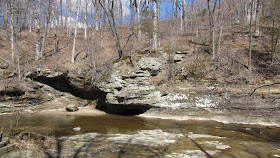
Our target for the day, as determined when I first met Bill at the Indiana Native Plant and Wildflower Society (INPAWS) annual conference in November 2010, was Snow Trillium (Trillium nivale). Little did I know when we set up our excursion that fall day that I would have already had the opportunity to see this species in 2011 with Lee Casebere. Regardless, I met up with Bill last Saturday morning, and it was definitely worth the trip.

It didn't take long to find Snow Trillium (above), which was in bloom just outside of the parking area in a somewhat degraded calcareous upland forest. After seeing our first population of blooming Snow Trillium, we continued to hike, finding more and more Snow Trillium and discussing the other plants we were seeing along the way. Just like every other spring, I couldn't resist photographing the blooming spring wildflowers. I don't know what it is about them... my collection contains loads of photos of all of the plants included in this post, but every spring, I cannot resist the urge to photograph them again. Maybe it is the fact that these plants are adapted to bloom early enough in the year that the trees towering above them have not yet produced leaves, allowing enough sunlight to penetrate to the forest floor. Maybe it is the glorious array of color produced almost instantaneously after the much anticipated build up as the days get longer and the ground temperature increases. Or maybe, just maybe, it is that wait itself that makes this suite of plants so alluring. If Harger's Goldenrod (Solidago canadensis var. hargeri) bloomed in April, would we not display the same exuberance that we do at the first signs of the burgundy blossoms of Bloody Butcher (Trillium recurvatum)? It's just that time of the year.

You've seen them before, and you'll most likely see them here again next year, but I simply cannot resist. Above is Harbinger of Spring (Erigenia bulbosa), and below is Spring Beauty (Claytonia virginica).

Bloodroot (Sanguinaria canadensis) blooms for a very short time, making it difficult to find that perfect plant to photograph. I can't say that I'd ever seen a plant at this stage, with the flowers still mostly closed but starting to open and with a pinkish tinge, somewhat reminiscent of a tulip (Tulipa sp.) flower.

The Bloodroot plants that I enjoy seeing the most, though, are those with open flowers and leaves that are still wrapped tightly around the stem, like the one below.

I had seen these wildflowers blooming already this year, but I had not yet seen the two species below.

Purple Cress (Cardamine douglassii, above) is sometimes confused with the more conservative Spring Cress (Cardamine bulbosa, not pictured), but the former has stems that are pubescent above, sepals that are usually deep purple at the tips, and petals that are often lavender (but sometimes white); the latter has stems that are hairless above, sepals that are usually green, and petals that are white). You can find Purple Cress in nearly any moist woods, regardless of how much disturbance has taken place. Regardless, each year, I take photos of this species the first several times I find it in flower.

And who can resist taking photos of flowering Dutchman's Breeches (Dicentra cucullaria, above)? This has to be one of the most interesting and attractive of the spring wildlfowers, does it not? Like many of the ephemerals, Dutchman's Breeches relies on insects for more than just pollination. In addition to the long-tongued bees that help this species to reproduce, ants play a very important role in seed dispersal of Dutchman's Breeches, as they find the sugary, fleshy seed appendages known as elaiasomes and take them back to their nest for a tasty feast. Unbeknownst to the ants, they are also spreading the seeds to new locations, giving rise to new populations of Dutchman's Breeches within the forest.
Finally, just a few more photos of Snow Trillium from last weekend, as my photographing obsession was taken to new heights with this species this spring (I took almost 100 photos of Snow Trillium at the three sites at which I saw it this year!).

The plant below was tiny, or my lens cap is enormous...

... and lastly, one of my favorite shots of Snow Trillium this year.

Nice photos Scott!
ReplyDeleteI have not seen that particular Cardamine before. No sign of our bloodroot yet here, what a late spring it is...
Heather
Very nice Scott. I'm hoping to see snow trillium one day soon!
ReplyDeleteThanks Heather. If Cardamine douglassii occurs in Minnesota, it would likely be in the southern or southeastern part of the state, but it doesn't appear that it would be common. Sorry to hear that your sping is so far behind... it looks like the birds are arriving there, at least.
ReplyDeleteThanks Mike. I'm not sure where the closest Snow Trillium would be for you, but I'm sure it would be worth the trip.
Very nice shots, my first and only Trillium of the 2011 season so far,was a toad trillium or toad shade, to some maybe not as glamorous ,but I find them very cool!
ReplyDeleteThanks Michael. Toadshade is a great trillium! Where are you that you are seeing it in flower?
ReplyDelete